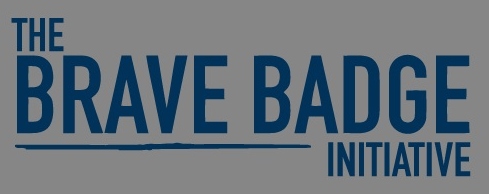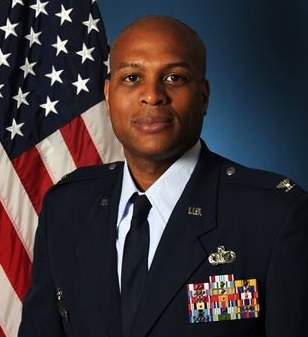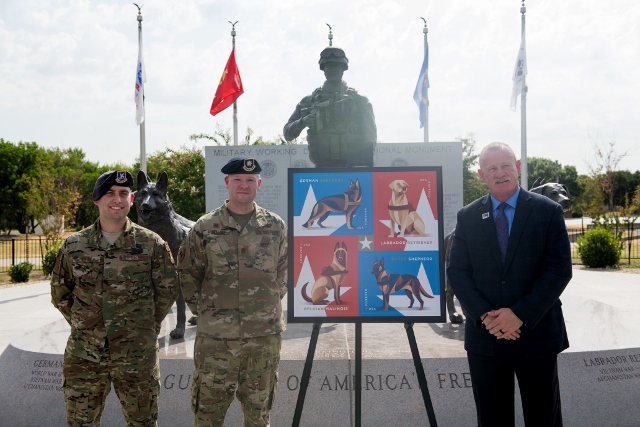
In 2017, the Air Force lost 62 Active Duty Airmen to suicide. Many of those losses being men and wom-en that wore the coveted blue beret. The Brave Badge Initiative is a social media platform that has strengthened the Security Forces community and is focused to changing the culture of every squadron. The founder of The Brave Badge Initiative, TSgt Calin A. Cronin, devised the idea after identifying the need for a crisis platform while stationed at Ramstein Air Base, Germany. After spending the next 6 months engineering the services of the platform, The Brave Badge Initiative was launched in September of 2018, just months after he arrived to Eielson AFB, Alaska.
The administrative team consists of TSgt Cronin; TSgt Sean Batson out of Malmstrom AFB, Montana; TSgt Bryan Thayer out of St. Paul ARS, Minnesota; TSgt Christian Kampe out of Joint Base Andrews, Maryland and SSgt David Borrego out of Malmstrom AFB, Montana. “Our goal is to ultimately lower suicides and fuel a climate of revitalized Security Forces members,” Cronin said. “We aspire to encourage active intervention and provide tools/lessons learned for comrades to lead someone to professional resources or resilient methods to overcome any Security Forces career-field related crisis.” He went on to add, “I am so grateful for this team and what they have given to our Defenders. They have taken on a great responsibility to be 24/7 available to any Defender that is battling with something that they can’t overcome.”
The Brave Badge Initiative offers several avenues to share personal insight and opinion across the career field. As the first Security Forces crisis platform to ever launch an anonymous messaging tool, the admin-istrative team has received dozens of testimonies from retired, active and recently-separated members who were struggling with anxiety, depression, or suicidal thoughts. Voting polls are also delivered to the masses to bring light to specific topics that affect our career field’s mental health. Other than providing resources, programs and articles of how to cope with issues that many Security Forces members are bat-tling every day, The Brave Badge Initiative has become a reporting tool to alert the career field when a tragic loss has occurred. “This is probably the hardest part of this responsibility. Not only is the team try-ing to cross-match information to make sure it is accurate, but we are trying to pay the ultimate respect to the unit and family left behind,” said Cronin. “Every time our team confirms a loss in the career field, we check on each other as Wingmen. Having the responsibility to inform others and trying to maintain an outpour of resiliency for our followers comes with a lot of stress. There is no doubt, we are synchronized and know that WE must be resilient to encourage the resiliency in others.” The platform has many plans for the future and seeks to find methods to assist Defender families who have lost Defender loved ones.
2019 has brought a large discussion to suicide and resiliency across the Air Force. Currently, the Air Force has lost over a 100 Airmen to suicide. On 1 August 2019, The CSAF General David Goldfein directed an Air Force-wide Resilience Tactical Pause for all Wings to execute, giving an opportunity to devise plans on lowering suicide and strengthening our readiness. Platforms such as The Brave Badge Initiative have echoed that stand-down and are encouraging their followers to be intrusive and active in helping other Defenders. The discussion of suicide and not being everyday ready as a Defender comes with many stigmas, yet the administrative team is working each day to bury those stigmas and instill bravery in each Defender to come forward if they are struggling.
With their more than 6,000 followers in less than a year, The Brave Badge Initiative has been commended for their contributions on several occasions. The Air University Command Chief, CMSgt Todd Simmons, who is also originally a Defender, has publicly recognized the platform on numerous occasions and has stated, “there were numerous grass-root efforts started over the past year to get after combating suicides, spreading awareness, and speaking directly to those in need of help. This is just one of those efforts I have watched and admired.”
The Brave Badge Initiative team encourages all Defenders and Airmen to find any platform or resource that exists that they can connect with. The Brave Badge Initiative is one of many platforms for the De-fender community, and they encourage Airmen to consider other resources like the Air Force’s Resiliency website and the local programs offered at installations across the globe. Their signature hashtag “#StayBrave” has turned into a movement to increase mental health awareness and communication among all ranks. Upholding their creed, “Saving Each Other, To Save Others”, the team at The Brave Badge Initiative is giving all Defenders a chance to rescue each other, no matter the crisis.
SAVING EACH OTHER, TO SAVE OTHERS
VETERAN CRISIS HOTLINE 1-800-273-8255 OPT 1.
Protection Strategies Incorporated Hiring

Protection Strategies Incorporated (PSI), a Service Disabled, Veteran-Owned Small Business (SDVOSB), engages industry recognized professionals worldwide to provide security management and consultant services to U.S. Departments and Agencies, international organizations, and commercial corporations.
PSI integrates a broad spectrum of security disciplines including: physical, technical, personnel, operational, communications, and cyber. PSI is an industry leader in risk, threat, and vulnerability assessments. We assist our customers in their needs to meet and exceed the compliance of safeguards and security requirements of critical infrastructures and provide the necessary tools to manage risk and strengthen security postures.
PSI is headquartered out of Oak Ridge, Tennessee. Our executive leadership is directed by highly recognized security services experts with decades of experience in physical and personnel security, security assessment and management, security program design and implementation, collective bargaining negotiations, and contract management. Our management support groups are comprised of individuals with backgrounds in guard force operations, law-enforcement, military service, federal executive-level positions, and private industry.
PSI lists current openings on the web site at: www.protectionsi.com/careers
Currently there are 37 openings on their CAREERS page and they include:
- Professional Role Player at Protection Strategies Incorporated in Oak Ridge, TN
- Security Specialist at Protection Strategies Incorporated in Germantown, MD
- Personnel Security Assistant at Protection Strategies Incorporated in Washington, DC
- Personnel Security Specialist II at Protection Strategies Incorporated in Huntsville, AL
- Background Investigator II at Protection Strategies Incorporated in Washington, DC
Our Path to a More Lethal and More Ready Defender!
By BG (Sel) Roy W. Collins, SF Director 24

It has been a fast month stepping in as your new Director of Security Forces. I made a promise during this time to assess where we are and more importantly, how to move us forward.
There is no question that our Security Forces Airmen deserve the absolute best opportunity to achieve their mission, whether it’s in the missile field, on a flight line or at any of our installation access control points. The Chief of Staff of the Air Force demands a More Lethal and More Ready Security Forces enterprise. How can I help you be the best Security Forces Airman you can be? This is the question I strive to answer every day. To that end, we are going back to basics in some regard while also preparing for the future by focusing on Training, Modernizing, Standardizing and Enhancing our Culture and Environment.
Training is the foundation that makes us more lethal and more ready. We will continue to focus and refine our efforts to ensure our Defenders are not only “qualified” but become proficient at the core skills. Repetitive training may not sound exciting but it’s what’s needed to ensure our professionals gain the muscle memory to efficiently respond to any situation to neutralize the threat, both home station and forward deployed. It’s also not just about repetition, which is important, but also the quality of the training our Airmen receive. Training must be executed with the importance it demands because failure to do so can lead to catastrophic consequences. Our National Defense Strategy states that “there is no sanctuary” and our mission remains the same no matter where we don the Blue Beret.
Modernizing our capabilities is a necessity to ensure our Defenders have the best weapons, personal gear, vehicles, communications equipment and command and control platforms. Our Defenders must have the most modernized equipment to provide them with the advantage to detect, deter and defeat the threat in any environment. Many of our Defenders have been achieving the mission without this and I commend you for the great work you’ve done. The budget battle is ongoing, every year, and though you might never hear about the details of these meetings, know your leadership team, with the support of the Chief of Staff, will continue to fight this battle.
Standardizing our equipment where it makes sense, is an important next step to ensure our Defenders possess the same resources and capabilities, no matter where they are. This standardization includes personal protective equipment and our duty equipment utilized every day on post. This will enable us to conduct our home station mission and our forward deployed mission with the same equipment and prevent the need for just-in-time training. Additionally, standardization of equipment will also feed our efforts to provide consistent training, as stated previously.
Enhancing the culture and environment for our Defenders is just as critical as the equipment you need to do your job. I cannot state this strongly enough. As we all know, this past year has been incredibly challenging across the Air Force and unfortunately, there is no magic solution. Trying to change the culture of any group is a difficult challenge because it requires a shift in mindset that happens slowly, one Defender at a time, one interaction at a time. Yes, leadership can and will provide guidance and support BUT we need each Defender to also be committed to a new culture; where connection and belonging matter, where despite your best efforts to handle a task alone, when you ask your wingman for support, they provide it without judgment. It is only in this way that we can be “Defender Strong!”
These focus areas are all critical to our success. We will see some successes and some challenges in this next year. We will learn from those challenges to do better next time and more importantly, we will celebrate each of you for the incredible commitment you show every day, proudly wearing the Blue Beret. It is my honor to serve you and I am extremely excited for what’s to come in this next year!
JBSA-Lackland, USPS San Antonio Honor Military Working Dogs
By Vicki Stein, AFIMSC Public Affairs, 15 August 2019

JOINT BASE SAN ANTONIO-LACKLAND, Texas – Members of the Security Forces community and the U.S. Postal Service gathered at the Military Working Dog Monument here Aug. 15 for a local ceremony to unveil the new U.S. Postal Service MWD forever stamp.
Headquarters USPS officially unveiled the stamp at the American Philatelic Society’s 133rd annual convention Aug. 1, in Omaha, Nebraska.
The Air Force Security Forces Center Air Force MWD Program Manager and trustee for the monument, Master Sgt. Steven Kaun, opened the ceremony saying the location was a fitting place since it was a historical site where MWD teams gather to show their respect and honor each other.
Kaun then introduced Robert D. Carr, Jr. the 28th Postmaster of San Antonio. Carr, a former Army Ranger who spent 30 years in the service, said the stamp collection included the four most common breeds of MWDs — the German Shepherd, Labrador Retriever, Belgian Malinois and Dutch Shepherd.
U.S. Air Force Master Sgt. Steven Kaun (left), USAF Military Working Dog program manager, Maj. Matthew Kowalski, 341st Training Squadron commander, and Robert Carr, Post Master of San Antonio, pose for a photo during the Military Working Dog Stamp ceremony Aug. 15, 2019, at Joint Base San Antonio-Medina Annex, Texas. The stamp honors dogs who have served in the U.S. armed forces since the U.S. Army created the War Dog Program K-9 Corps and began training man’s best friend in March 1942. (U.S. Air Force photo by Sarayuth Pinthong)
“It was my privilege to be in the 82nd Airborne in the Ranger battalion to work alongside the dog handlers and their military working dogs and see them in action in real world environments,” Carr said. “It’s amazing what these animals can do.”
The stamp honors dogs who have served in the U.S. Armed Forces over the past century, starting in World War I when dogs were originally enlisted by the Quartermaster Corps, and a diversity of breeds was accepted.
Carr said the idea of working dogs went even further back to the founding of our country and noted there’s a memo from the first Postmaster General Benjamin Franklin in the Postal Headquarters where Franklin recommended using dogs in the Armed Forces in the War of Independence because they could confound the enemy and cause distraction.
Maj. Matthew Kowalski, 341st Training Squadron commander, joined Carr and Kaun to unveil the Forever MWD stamp to the applause and barking of attendees, which included current MWDs and puppies from the Defense Department Breeding Program.
The DOD Military Working Dog program, the world’s largest training center for military dogs and handlers, has been based at JBSA-Lackland since 1958. The DOD Military Working Dog Veterinary Service and the Holland Working Dog Hospital, the largest for military working dogs, are also located on JBSA-Lackland.
Working with their handlers, military working dogs are called upon to deter and detect. They are trained in narcotics, explosives and intruder detection, and those duties often place them in harm’s way.
The Military Working Dog Teams National Monument is a U.S. National Monument that represents all handlers, dogs and veterinary support from all military service branches. The monument grounds include a 3,000 square foot granite plaza, granite pedestals, granite history wall, granite benches and water fountain. The granite pedestals have large bronze statues of dogs and handlers. One of the inscriptions reads: “Dedicated to all U.S. Military Working Dog Handlers and their beloved dogs who defend America from harm, defeat the enemy, and save lives.”
American Lake Veteran’s Golf Course
By: Capt (ret) David Van Pay

As an avid golfer, I’ve played nearly all the public golf courses in western Washington. One of the neat courses I’ve played is the American Lake Veteran’s Golf course, Lakewood, WA. The front nine holes is old school. Wide open fairways with tiny greens. The back nine was designed and built by Jack Nicklaus a couple years ago. The back nine plays like a resort course that holds your attention on every shot. The most amazing part of this story is the mission and the all-volunteer staff who manage and operate the course for its Veteran patrons.
The mission of the American Lake Veterans Golf Course is to provide affordable services to veterans, active members of the armed forces and their legal dependents. Green fees for 18 holes of golf are $15. The annual fee is $200. Fees are waived for disabled and elderly veterans. Other services with no fees include golf lessons, mobility impaired golf carts and golf equipment donated by the public. Donated used clubs are refurbished and given to interested veterans. Last year, they issued over 1600 sets of clubs to local veterans.
Programs and events include Blind Rehab training, golf equipment and golf tournaments for the blind. They also organize “Down Range” reunion for disabled golfers, wounded warrior tournaments VA hospital in-patient picnics and programs for homeless veterans. They also gather Christmas presents for VA Hospital in-patients.
All these programs and the care and maintenance of the golf course are managed by 230 dedicated volunteers. There are no paid employees. A volunteer kitchen staff purchases and prepares food enjoyed by golfers playing in various tournaments throughout the year. Other food service programs include food for VA Hospital in-patients and homeless veterans and their dependents.
Since 2004, Friends of ALVGC have provided over $7 million worth of improvements to the golf course, including buildings, a $1.4 million Rehab Learning Center which includes a golf simulator. They also installed a $600K irrigation system and purchased 12 mobility impaired golf carts. They also obtained 72 new golf carts through donations from local golf courses, service clubs and private people.
The course is the only ADA compatible golf course in the country and has equipment and facilities to assist disabled veterans learn and enjoy the game of golf. The “Friends” are currently raising funds to extensively modify the old front nine holes to better accommodate mobility impaired golf carts and improve grounds maintenance.
In May 2017, the VA signed over the golf course to the Friends of ALVGC. The group continues to maintain the golf course and equipment and programs in an exceptional fashion. Truly a labor of love for this amazing group of veteran volunteers.
The Evergreen-Ron Blatman Chapter recently donated a set of golf club to the “Friends.” In turn, they will pass the clubs onto a needy veteran who has an interest in playing golf.
If you or your chapter has an interest or want more information, check out their “Friends” on their website at www.veterangolf.org.
Page 20 of 50


